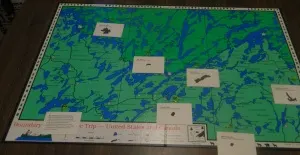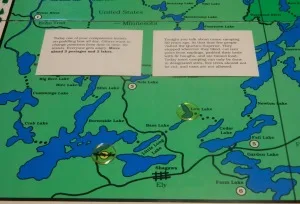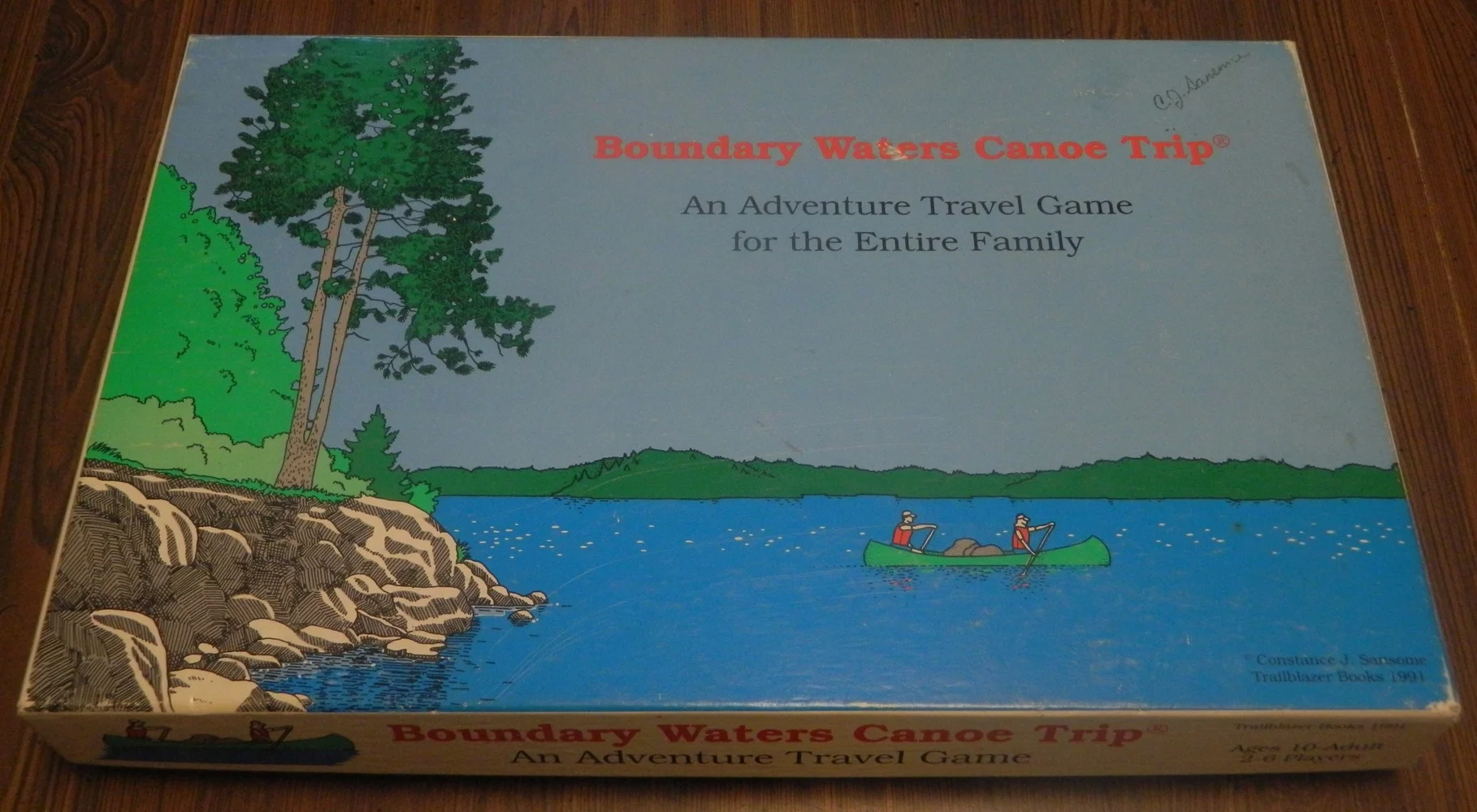How to Play:
“Boundary Waters Canoe Trip” is an obscure 1991 board game from Trailblazer Books that is hard to find any information on, but was most likely a short-printed game only sold in Minnesota or the general Midwest. The object of the game is to complete an imaginary canoe trip through the Boundary Waters in Minnesota and Canada, visiting six different lakes (three American ones and three Canadian ones) and returning home. The first player to complete their trip and return to their entry point wins.
To start the game, each player draws an entry card and six destination cards. Players place their canoe token on the lake they are starting on (whatever the entry card says) and find the other six lakes they’ll have to visit (this might take awhile since there are a ton of lakes on the game board and the lakes are hard to find) and form their strategy.

Each turn goes like this: draw and read a travel card (which will have a lot of flavor text then an amount of portages and lakes you can move), move your canoe the amount of portages (carrying your canoe across land) and lakes the card says (if you arrive at one of your destinations, you stop and camp there and can’t use your additional moves), and draw and read a camp card (all of which are just flavor text meant to immerse you in the game and/or help you learn something about the outdoors). Before you enter Canada, you must stop at a ranger station and pick up a Canadian permit. After the camp card is read, your turn is done and play continues clockwise until someone has visited all the lakes on their trip and returned to their entry point. Basically, “Boundary Waters Canoe Trip” is just an overly complicated (mostly due to the map) roll-and-move game except with cards instead of dice.

My Thoughts:
For those who don’t know, the Boundary Waters are a famous canoeing destination in the waters that separate Minnesota from Ontario. I picked up this game at a thrift store (on clearance even, you know a game is obscure or bad if it hits the clearance section of a thrift store) mainly because I’m actually interested in canoeing them one day. While that day is a long way away (though I will definitely write about it when I start to train), I tried to play out on of my dreams in board game form with “Boundary Waters Canoe Trip.” Unfortunately, the game is basically just a roll-and-move game with a very confusing and tough to read map.
First of all, this game is noticeably a very low-budget game. The board is very sturdy (and big) but the rest of the game’s contents are hundreds of cards (relatively sturdy stock) and bingo markers being used to move and mark your destinations. Obviously being a small production, this game isn’t super high quality but it could have been much worse (and made even cheaper).
The board is one of the biggest problems with the game. While it is relatively high-quality, the board is very large (it will fill up most of a mid-sized dining table) and there are almost 200 lakes pictured (and in pretty small print) making it really difficult to find all your destinations and create an efficient route that actually works. It is also sometimes hard to see where one lake ends and another begins, which paths are navigable, and whether or not certain lakes connect (so in some cases you just have to guess how far your canoe can go in a turn). For a game that is basically just a roll-and-move game, the map on the board is overly complicated and difficult to figure out. A grid of some sort (lettered and numbered so you could just look for a letter and number and find the general vicinity of the lake you’re looking for) would have been nice. The cards do tell you whether the lake is in the eastern, central, or western section of the map (as well as if it is an American or Canadian lake) but a more precise grid would have been better.
One thing that could be either a positive or a negative depending on your interest in the outdoors and canoeing, is the ridiculous amount of flavor text. While I think some of the cards go into way too much detail, as a wannabee-outdoors nerd, I personally didn’t mind it too much. However, the players I played with hated the copious amounts of flavor text and it’s not like I can blame them. Some of them fill up the entire card and since none of the text actually effects play (except for the last sentence in most cases), it’s pretty much pointless. The camp cards are the worst since none of them effect play and they basically just describe your imaginary nights spent under the stars. Most likely if you are reading this review you are probably interested in the outdoors and canoeing so this shouldn’t be much of a negative for most people. Also, you can always just skip the text if you don’t care about it.
The worst part of the game is just the lack of any interesting game mechanics. There are about the same number of mechanics in “Boundary Waters Canoe Trip” as there are in “Candy Land.” While this game at least has everybody going to different locations, the only basic mechanic is moving (at least 95% of the cards move you forward and the only other cards are “lose your turn” cards, most of which are pointless because you then get an extra turn the next time around). Canoeing isn’t the most dangerous outdoor activity out there, but there are a lot of things that could happen. For example, you could get lost and go the wrong direction (maybe this would have you move backwards a certain amount of places) or your canoe could become damaged and force you to move slower (maybe players would be given the option to use their turn to fix it and receive no further penalties or take off 1 portage and 1 lake from every subsequent travel card they draw if they don’t want to waste their turn). Since a canoe tour also requires a lot of survival skills and planning ahead, the game also could have added in food and equipment (you would sometimes have to go out of your way to visit a city to restock your supplies). If you run out of supplies, you would have to spend your turn foraging but if you planned ahead, you would just waste a couple movements instead of an entire turn. A good board game forces you to make a lot of interesting decisions. In this game, you just draw a card and move.
Ultimately, the lack of interesting mechanics is what really kills the game. There could have been an interesting game here if more time was spent on the game’s mechanics instead of basically making it a roll-and-move game and calling it a day.
Final Verdict:
One day I will canoe the Boundary Waters. I just hope it’s far more interesting than this bland roll-and-move game. The only actual positive I can come up with is that “Boundary Waters Canoe Trip” has a lot of information about the area and the outdoors to read while you are playing (and if you aren’t interested in the outdoors, this can turn into a negative). Otherwise, it is extremely boring and hard to find anything on the board. At least with “Candy Land,” you know where you’re going.
If you don’t like canoeing or the outdoors, you probably wouldn’t even be reading this review but I definitely recommend staying away from this game. Unfortunately, I can’t even recommend it for outdoors people or canoeists since there isn’t much of a game here.

